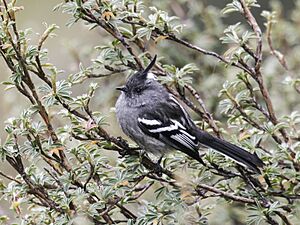Ash-breasted tit-tyrant facts for kids
Quick facts for kids Ash-breasted tit-tyrant |
|
|---|---|
 |
|
| Conservation status | |
| Scientific classification | |
| Genus: |
Anairetes
|
| Species: |
alpinus
|
 |
|
The ash-breasted tit-tyrant (Anairetes alpinus) is a small bird that lives high up in the Andes Mountains in Peru and Bolivia. These birds are usually found at very high places, between 3,700 and 4,600 meters above sea level.
Sadly, the ash-breasted tit-tyrant is an endangered species. Their numbers are getting smaller because of different dangers. You can spot them by their dark gray feathers, with two white stripes on their wings and around their tail. They are quite rare and only live in specific areas. Their natural home is in wet mountain forests in warm, tropical places. They are mostly threatened because their homes are disappearing.
Contents
What Does the Ash-breasted Tit-tyrant Look Like?
The ash-breasted tit-tyrant is easy to spot because of its gray color. It's a small, round bird, about 13 centimeters long. The top part of its body is dark gray, and its belly is a lighter gray.
It has two white stripes across its wings. There are also white outlines around its tail. This bird has a long black tail and a black spot on top of its head. Just behind that black spot, you can see some white feathers on its crown.
Where Does the Ash-breasted Tit-tyrant Live?
The ash-breasted tit-tyrant often lives in places like rainforests, grasslands, or on mountain slopes. They build strong, thick nests in these areas. These birds do not move to different places for seasons. This causes problems for them because their homes are getting smaller and less healthy.
This bird is known as a flycatcher. It often flies around in pairs or with its family group.
What Does the Ash-breasted Tit-tyrant Eat?
Scientists don't know everything about what the ash-breasted tit-tyrant eats. But it is often seen eating insects. This means it is an insect-eating bird.
How Many Ash-breasted Tit-tyrants Are Left?
In 2016, the ash-breasted tit-tyrant was put on the IUCN Red List as endangered. They were also considered threatened back in 1988.
Today, there are only about 150 to 700 adult birds left. In total, there are likely between 250 and 999 of these birds. They only live in their specific mountain homes. These homes are spread across 11 to 100 different spots. They are found at very high elevations, from 3,700 to 4,500 meters.
What Sounds Do They Make?
The ash-breasted tit-tyrant is known for its longer chirps, which sound more like a song than a short call. Their song often ends with a "peep" or "pip" sound.
Why Are They in Danger?
The homes of the ash-breasted tit-tyrant are threatened by fires. Also, efforts to stop fires can sometimes harm their habitat. They are also at risk because of ranching and livestock farming. In Bolivia, more than 90% of the forests where these birds live have been changed by people.
What Is Being Done to Help Them?
There isn't a special plan just for the ash-breasted tit-tyrant to help them recover. However, there are places set aside to protect nature. Organizations like CEPF Armonia are working to save these birds and help their population grow over time.
Some ideas to help them include:
- Keeping farm areas separate from forest areas.
- Doing studies to keep track of how many birds there are.


